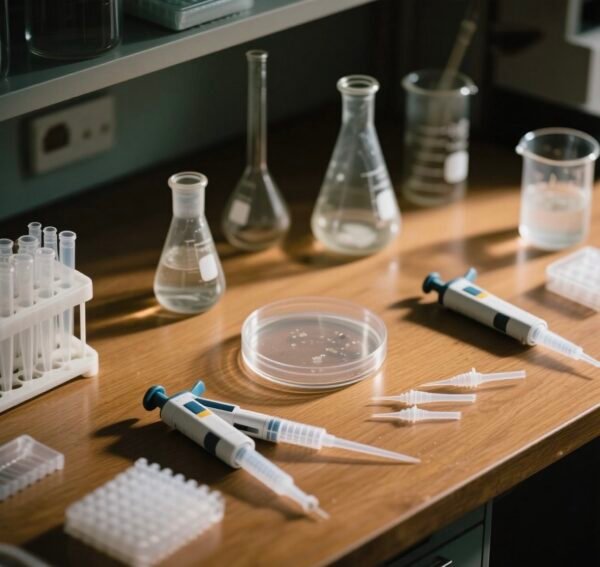Introduction
The accuracy and reliability of laboratory analyses depend not only on precise instruments but also on the integrity of consumables such as pipette tips, Petri dishes, culture flasks, and microcentrifuge tubes. These materials come into direct contact with biological samples and reagents, and any microbial contamination poses a risk of:
- Compromised data validity
- False positive or negative results
- Increased experimental variability
- Threats to operator health and safety
In recent years, integrating inorganic antimicrobial agents into laboratory consumables has emerged as an effective preventive strategy to maintain sterility and data integrity, especially in high-throughput and sensitive assay environments.
Rationale for Incorporating Antimicrobial Agents
Laboratory consumables are often produced under cleanroom conditions and sterilized via gamma irradiation or ethylene oxide. However, post-sterilization contamination can still occur during storage, handling, or prolonged experimental workflows.
Key reasons for antimicrobial integration include:
- Continuous Microbial Suppression
Unlike sterilization, which is a one-time intervention, embedded antimicrobial agents provide ongoi - Reduced Biofilm Formation
Biofilms can form on the surfaces of tubes and culture plates, leading to persistent contamination that is difficult to elimin - Improved Consumable Longevity
Preventing microbial degradation of polymer-based consumables maintains their mechanical and o
Mechanisms of Action
Silver Ions (Ag+)
- Mode: Silver ions interact with bacterial cell walls, disrupt membrane integrity, and interfere with intracellular processes, leading to rapid cell death.
- Advantages:
- Broad-spectrum efficacy against Gram-positive and Gram-negative bacteria
- Effective at low ppm concentrations
- Stable and non-volatile under laboratory conditions
Copper Ions (Cu2+)
- Mode: Copper induces oxidative stress within microbial cells by generating reactive oxygen species (ROS), damaging cellular proteins and DNA.
- Advantages:
- Strong bactericidal and fungicidal properties
- Effective against resistant strains
- Relatively low cost for large-volume consumables
Zinc Ions (Zn2+)
- Mode: Zinc ions inhibit key microbial enzymatic pathways, limiting growth and replicat
- Advantages:
- Mild antimicrobial effect suitable for applications requiring minimal leaching risk
- Often combined with silver or copper for synergistic performance
Integration Process in Consumable Manufacturing
- Masterbatch Preparation
Inorganic antimicrobial agents are incorporated into polymer masterbatches (e.g. polypropylene or polystyrene) via controlled extrusion to ensure uni - Injection Molding or Extrusion
The masterbatch is processed into final consumable products using standard molding techniques. The embedded agents remain locked within the polymer mat - Quality Control Testing
Final products undergo standardized antimicrobial efficacy testing, such as ISO 22196 or JIS Z 2801, to quantify bacterial reduction rates.
Performance Data Highlights
Recent studies demonstrate:
- Silver-infused pipette tips achieved a >99% reduction in E. coli and S. aureus viability within 24 hours.
- Copper-blended Petri dishes inhibited fungal growth (e.g. Aspergillus niger) on contact surfaces, reducing contamination rates in environmental microbiology assays.
- Zinc-enhanced microcentrifuge tubes maintained sterile surfaces during extended cell culture storage, improving viability assessments.
Regulatory and Safety Considerations
- Leaching Risk: Concentrations are carefully formulated to minimize metal ion leaching into samples, ensuring no interference with analytical assays or cell cultu
- Compliance: Consumables with antimicrobial agents must comply with ISO, FDA, and regional safety regulations for laboratory materials.
- Material Properties: The addition of antimicrobial agents should not affect transparency, elasticity, or chemical resistance critical to experimental procedures.
Applications in Modern Laboratories
| Laboratory Type | Application | Benefit |
|---|---|---|
| Molecular Biology | Pipette tips, PCR plates | Prevent nucleic acid degradation by bacteria |
| Cell Culture | Flasks, dishes, tubes | Reduce contamination in long-term culture |
| Microbiology | Petri dishes, sampling bags | Minimize background contamination |
| Clinical Diagnostics | Sample vials, transport tubes | Enhance sterility during transit |
Limitations and Future Development
- Cost Impact: The integration of silver or copper increases manufacturing costs, though these are offset by reduced contamination-related expe
- Assay Interference: Trace metal presence requires validation to ensure compatibility with sensitive assays (e.g. ICP-MS, enzyme-based tests).
- Innovation Trends: Nanotechnology is advancing antimicrobial agent efficacy while minimizing required dosages, supporting broader adoption in consumables without cost or compatibility trade-offs.
Conclusion
Embedding antimicrobial agents in laboratory consumables represents a proactive approach to safeguarding experimental accuracy, ensuring operator safety, and enhancing operational efficiency. As research demands increase and contamination risks remain ever-present, these materials will form an integral part of next-generation laboratory best practices.
✉️ Partner With Us
We develop silver, copper, and zinc-based antimicrobial formulations optimized for laboratory consumable manufacturing. Contact us to explore customized solutions that ensure your products meet the highest standards of sterility and reliability.


-300x210.jpg)
